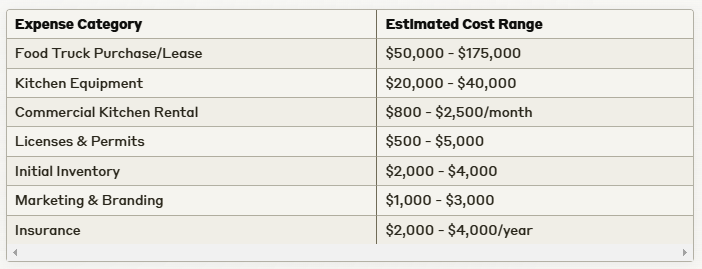Mirroring the global trend, food truck market in Australia is sizzling hot. The Australian mobile food market is estimated to be worth over $1 billion AUD and is projected for further growth. People from diverse ethnicity and vibrant food culture provides a perfect platform for food trucks to showcase their offerings and providing an exciting and unique dining experience for their customers. Starting a food truck business in Australia is an excellent way to dive into the food industry, but it can also be costly without proper research.
The surge in popularity of food truck businesses in Australia can be attributed to several factors.
- Affordability: Food trucks offer a lower barrier to entry for aspiring restaurateurs compared to opening a brick-and-mortar restaurant.
- Variety and Innovation: Food trucks provide a platform for culinary creativity, allowing chefs to create new cuisines and offer unique and diverse food options to customers craving something different.
- Convenience: Food trucks cater to people with busy lifestyles, who has limited time to cook for themselves, offering quick and delicious meals on the go.
- Location Flexibility: Food Trucks can move to areas with high foot falls, like festivals, events, or central business districts, maximizing exposure and sales.
Now, we will explore the various costs associated with starting a food truck business in Australia, with a focus on Melbourne, Perth, etc.
Food Truck Start-up Cost Includes –
Startup Costs
Starting a food truck business in Australia involves a variety of costs, including vehicle acquisition, setup and wrap, equipment, licenses, insurance, and permits. The initial investment can vary depending on the type of food truck you plan to run, its size, and the equipment you need.
Vehicle Acquisition
The first significant cost of starting a food truck business in Australia is the acquisition of a suitable vehicle. The cost of acquiring a truck can range from $20,000 to $150,000 or more, depending on the size, quality, and age of the truck. Taking a loan can help you manage these significant expenses and get your business off the ground. You can consider purchasing a used truck to reduce the initial cost, but it may require additional maintenance and repairs. Additionally, you can choose to lease a truck or obtain financing to reduce the initial investment.
Setup and Wrap
Once you have acquired a vehicle, the next step is to convert it into a food truck. This includes installing a commercial kitchen, equipment, and storage space, which can cost between $30,000 to $80,000, depending on the size and complexity of the truck. You may also want to consider wrapping the truck with a unique design or branding, which can cost around $3,000 to $5,000.
Equipment
Equipment costs are another significant expense to consider when starting a food truck business in Australia. You will need to purchase a variety of equipment, including refrigeration units, cooking equipment, and utensils, which can cost between $10,000 to $30,000. You can consider purchasing used equipment to reduce the cost or negotiate with suppliers to get a better deal.
Food and Beverage Costs
The cost of food and beverages is another significant expense for a food truck business. You will need to purchase ingredients, spices, and condiments, which can vary depending on your menu items. You may need to factor in the cost of sourcing fresh and locally sourced ingredients, which can be higher. Additionally, you will need to consider the cost of packaging and utensils.
Electricity and Other Utilities
Another significant expense associated with starting a food truck business in Australia is the cost of electricity and other utilities. Depending on your equipment and usage, the cost of electricity can vary significantly. You will also need to consider other utilities such as gas, water, and waste disposal.
Licenses, Insurance, and Permits
Operating a food truck business in Australia requires obtaining various licenses, insurance, and permits from different authorities. These include a food business license, a mobile food vending permit, a food safety supervisor certificate, and public liability insurance. The cost of obtaining these licenses and permits can range from a few hundred to a few thousand dollars, depending on the state and local government requirements.
Point of Sale (POS) System
A POS system is a crucial tool for food truck businesses to efficiently manage transactions and inventory. The cost of a dependable POS system can range from $1,500 to $3,000, depending on the features and capabilities desired. However, the expense may be reduced by subscribing to Foodship‘s POS, which is as low as AUD 40 per month. Additionally, the affordability and user-friendliness of Foodship’s POS system make it accessible to any food truck business, regardless of their budget or technological expertise.
Management and Labor Costs
Running a food truck business in Australia also requires management and labor costs. You may need to hire employees to help run the business, which includes wages, payroll taxes, and workers’ compensation insurance. Additionally, you will need to factor in other expenses such as marketing, accounting, and legal fees.
Branding and Design
One should never underestimate the power of branding and marketing for promotion of new food business. While your food might be the star, but a visually appealing signage is key to grabbing attention on the streets. You should deploy a professional design for your food truck. Additionally, budget for marketing materials like printed menus and building a social media presence. These elements will help you connect with customers, build your brand identity, and drive sales.
Tips to Reduce Startup Costs
Here are some tips to help reduce startup costs for your food truck business in Australia:
Research and Plan: Do thorough research on the cost of vehicles, equipment, and supplies before starting your food truck business. Create a detailed business plan that outlines your expenses and projected income.
Choose Your Location Wisely: Choose locations that have high foot traffic and demand for food trucks. This can help you maximize your sales and reduce your travel costs.
Research Suppliers: Research suppliers and negotiate with them to get better deals on equipment and supplies. You can also consider purchasing used equipment to reduce your costs.
Purchase Used Equipment: Consider purchasing used equipment to reduce your conversion costs. You can also negotiate with suppliers to get better deals.
Hire Staff Only When Required: Only hire staff when necessary.
Start Small: Consider starting with a smaller truck or menu to reduce your initial costs. You can always expand later as your business grows.
Minimize Electricity Usage: Minimize your electricity usage by using energy-efficient equipment and turning off equipment when not in use. This can help reduce your electricity costs and improve your bottom line.
Be Efficient: Plan your routes and schedules to maximize your time and reduce your fuel costs. Optimize your menu to reduce food waste and increase profitability.
- Look for used trucks or trailers: To save money starting your food truck business, consider exploring the market for well-maintained used trucks or trailers. This can be a significant cost-saver compared to purchasing brand new equipment.
- Designate multi-purpose equipment: While purchasing gadget or equipment for your food truck, opt for multi-purpose equipment whenever possible. A griddle that can handle both burgers and veggies or a steamer that works for dumplings and seafood can save you space and money compared to buying specialized tools.
Conclusion
Starting a food truck business in Australia can be a rewarding and profitable venture, but it’s essential to understand the costs involved. Vehicle acquisition and conversion costs, licenses and permits, food and supply costs, and labor costs are all significant expenses to consider. However, with careful planning and cost management, you can keep those costs under control. Research your options thoroughly, secure financing if needed, and create a detailed business plan that outlines your expenses and revenue streams. With a sound strategy and costing, your food truck dream can become a reality. So, roll up your sleeves, do your research, and get ready to hit the road to culinary success!





